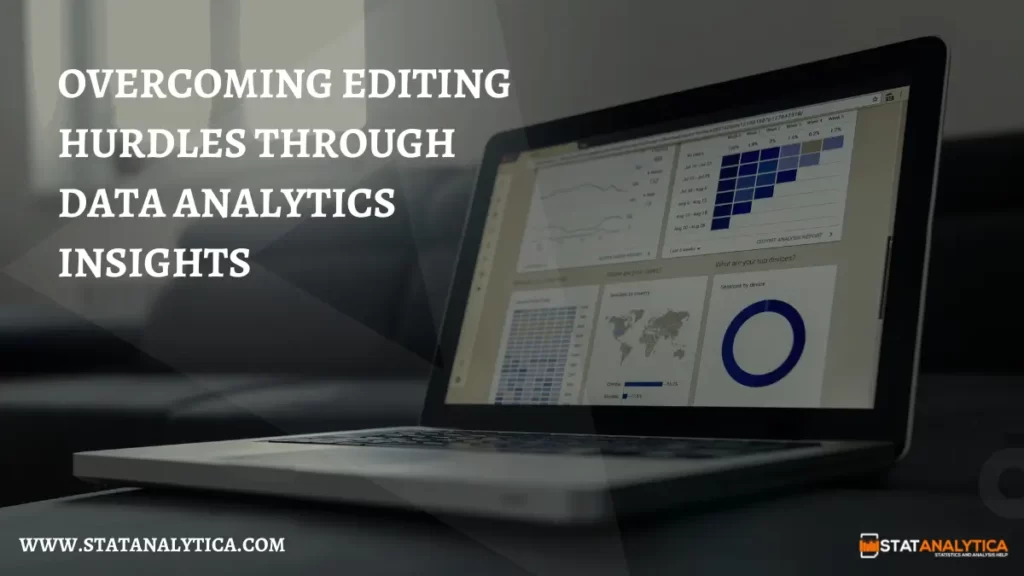Facing editing hurdles and seeking a smarter way to tackle them head-on? Enter the powerful world of data analytics!
Whether you’re editing text or enhancing images with the help of a photo editor, data analytics can elevate your game by pinpointing recurring errors, identifying underlying patterns, guiding action plan formations, providing predictive foresight for upcoming issues, and assessing the success of your applied solutions.
In this breakdown, we’ll take a deep dive into each of these areas and guide you toward harnessing data analytics insights to ace your edits every single time. Ready to leapfrog over those commonplace hindrances? Let’s get started!
Editing Hurdles Through Data Analytics Insights
Table of Contents
1. Leverage Data Analytics To Spot Common Editing Issues
In essence, think of data analytics as your watchdog. It scans through large amounts of content and easily identifies recurring errors that might slip past human oversight. This could range from grammatical mistakes, and repetition of ideas, to awkward phrasing.
Data analytics accomplishes this task by comparing your edits with vast databases of linguistics rules or previously edited work examples. Analytics tools then detect anomalies and flag them as potential areas needing improvement.
By employing data analytics in your initial stages of editing, you’re not just betting on random checks anymore. Instead, you’re strategically homing in on problem-prone areas based on concrete evidence.
In short: Data analytics provides an eagle-eyed view of your content landscape. It uncovers where exactly the pitfalls lie so you can address them head-on!
2. Use Analytics Insights To Recognize Error Patterns
Here’s where things get interesting. By using data analytics, you’re not just finding individual errors – you’re latching onto entire patterns of mistakes that recur throughout your content. How so, you ask? Well, it’s all about the algorithm.
In both text and photo editing, algorithms can detect repeated issues like poor sentence structure or a tendency for over-saturation in pictures. This is possible due to machine learning capabilities which allow the system to “learn” from previous corrections made in the past. Utilizing an AI photo editor can further enhance your image editing process by leveraging advanced algorithms to automatically adjust and improve photo quality, saving you time and ensuring consistent results.
Let’s say with the help of a photo editor you’ve been consistently adjusting contrast levels. Analytics tools catch onto this trend and alert you about consistent over or under-contrasting in your photo edits moving forward.
So essentially, what learning from patterns gets you is foresight – like arming yourself with predictive capabilities for recurring trouble spots before they happen again. You aren’t just fixing errors; armed with analytics insights, now you’re outsmarting them!
3. Formulate an Action Plan Based on These Findings To Anticipate and Resolve Future Errors
After using data analytics to identify common issues and recognize patterns in your edits, the next step is acting on this vital information. And that’s where an action plan comes swooping in!
This looks different for everyone, most importantly it should be tailored according to the unique challenges highlighted by your data analysis report. If you notice a certain type of mistake popping up frequently – maybe punctuation misuse or overuse of specific words – the action plan will focus on extra vigilance for those issues.
The essence is simple — every time you sit down with a piece of content to edit, your action plan serves as a troubleshooting guidebook. It outlines specific areas to pay extra attention to based on your past missteps identified through analytics.
The bottom line? An effective action plan converts insights from data analytics into actionable steps, ensuring smarter editing and fewer repeated errors. Effective use of data leads to powerful preventative actions.
4. Consider Predictive Analysis To Mitigate Hurdles Before They Occur
Predictive analysis is just as cool as it sounds. By analyzing your past editing blunders and current workflow, this facet of data analytics lets you foresee potential edits before they even crop up!
See, predictive analysis takes into account historical data—like pattern-forming mistakes you frequently make—and combines it with present inputs that could signal an imminent error. It’s essentially a time machine for your edits.
With this tool in your arsenal, you’re no longer doing damage control; instead, you are intervening proactively based on calculated predictions.
Think about it – kind of like seeing the future of your work and making sure it looks splendid! So yes, with predictive analysis backing your decisions up, you get to edit smarter, not harder!
5. Regularly Re-Evaluate Your Progress and Solutions
Once you’re armed with data analytics and you’ve put your brand new action plan into practice, don’t sit back just yet. Editing involves continuous evolution – so should your strategy.
Re-evaluate your progress regularly using data analytics applications. This assessment allows you to gauge if your actions have actually mitigated common issues or if they need tweaking.
Whether it’s re-adjusting points in your action plan, fine-tuning predictive measures, or identifying new patterns of errors unnoticed before, regular check-ins keep your editing approach fresh and highly effective.
Remember – good editors never stop learning and growing! Your editing skills are a living, breathing entity that thrives on consistent attention and intelligent adaptation.
Conclusion: Data Analytics Insights
There’s no time like the present to start leveraging data analytics for your editing process. Arm yourself with these strategic insights and bid adieu to irrelevant errors and repetitive mistakes. Step into the realm of smart, efficient, and predictive editing today – the transformation in your work quality will speak volumes!


